About
Special News
Logan's Page
Jacoby's Page
Our Travel Index
Tracks Ahead Related Trips
Contact
Cuba - 2001
Tracks Ahead & Trains Unlimited Tours
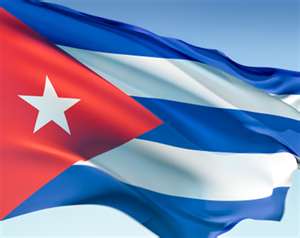 |
A step back to the United States, circa 1959 - with some surprises |
March 7
Our Cuban trip was through the auspices of Trains Unlimited Tours, and it's director, Chris Skow. The trip started with a late morning flight out of Milwaukee. The intrepid crew of John, Gail, and I are meeting Jim Peck in Miami. We had a very short turnaround in Detroit, with the next flight out at 9PM. I practically always check the monitor screens when I exit a plane, as connecting flight gates often change. This time, the monitor that featured the “M’s” was burned out. So we all hustled down to what we thought was our gate, only to find out that the real gate had been moved to four away from the arrival gate. Damn. But we got our exercise. And we finally left the Midwestern cold and arrived in Miami, where it was nice and warm and sunny. We met Jim, shuttled over the Hampton Inn. and took a cab down to the Versailles Restaurant (authentic Cuban food), figuring we might as well get acclimated to the cuisine.
March 8
There are so many unknowns about this trip, so my anxiety level is high. We made the Air Jamaica flight without a problem. The long check-in line moved quickly, and the airline was able to check our entire luggage through to Havana. I have decided that if I have to fly, Midwest Express (now defunct) was the only way to go. As Barb says, “If Midwest doesn’t go here, then neither do I.” Air Jamaica is a second choice. While the seats are coach and cramped, the service, food, and alcohol were sufficient to make up for it. So we arrived in Montego Bay, to find the airport under construction. That pretty much makes it universal, as everywhere we have flown for Tracks Ahead, the airports have some construction project. We were able to purchase our tickets to Havana, and just waited to board the plane. We finally departed, although a little late, and descended into Jose Marti International Airport in Havana, Cuba.
I never really thought that I would ever get here. It
just goes to
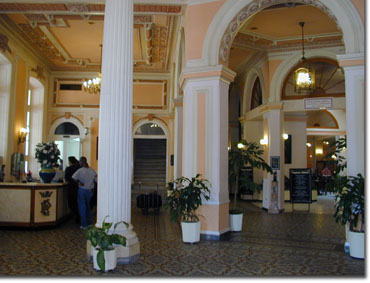 show
that if you want to do something, you have but to do it. We got
hassled a little at our entrance. Our visas were different from
the standard tourist cards, being official journalist visas. I
don't think the customs guy had ever seen one. But after a few
phone calls and some polite questioning, we were on our way out into the
warm afternoon.
show
that if you want to do something, you have but to do it. We got
hassled a little at our entrance. Our visas were different from
the standard tourist cards, being official journalist visas. I
don't think the customs guy had ever seen one. But after a few
phone calls and some polite questioning, we were on our way out into the
warm afternoon.
We had a rather fun ride into Havana, and found
ourselves at the Plaza Hotel, which is a restored wonder at the entrance
to Old Havana. I must say, that if you are into old cars, this is
the place to come. Everything is just like the 1950’s. So
there is a mixture of Peugeot, Fiat, Lada,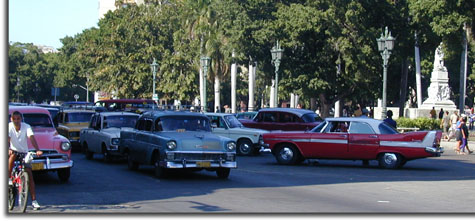 Moskovich and all ’52-'62 American models. There are old Chevys,
Fords, Chryslers, Edsels, Buicks, Jeeps, Nash products - more than I can
name here - that are in great working order. The P
Moskovich and all ’52-'62 American models. There are old Chevys,
Fords, Chryslers, Edsels, Buicks, Jeeps, Nash products - more than I can
name here - that are in great working order. The P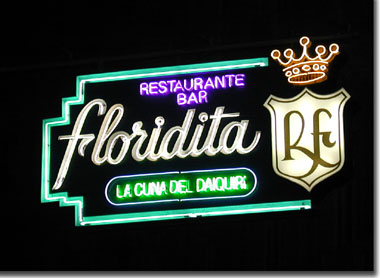 laza
Hotel is a beautiful, restored place, and is crowded with tourists.
The guidebooks say that Cuba is basing a lot of its new economy on
tourism, and things are really rockin’. The bar where Ernst
Hemingway drank (well, one of them) is right around the corner. So
we toddled off to La Floridita and had a couple of drinks in
Hemmingway’s honor. We went to Bogadita for a typical Cuban dinner
of beef hash, red beans and rice, and fried bananas. Jim and Gail headed
out for another bar, but I am pooped. More tomorrow as we explore more
of Havana.
laza
Hotel is a beautiful, restored place, and is crowded with tourists.
The guidebooks say that Cuba is basing a lot of its new economy on
tourism, and things are really rockin’. The bar where Ernst
Hemingway drank (well, one of them) is right around the corner. So
we toddled off to La Floridita and had a couple of drinks in
Hemmingway’s honor. We went to Bogadita for a typical Cuban dinner
of beef hash, red beans and rice, and fried bananas. Jim and Gail headed
out for another bar, but I am pooped. More tomorrow as we explore more
of Havana.
March 9
I finally
roused myself about 7:30 and headed up for breakfast on the roof of the
hotel. I ran into Jim, and as we ate on the veranda, there, spread
before us, was Havana, with the Bay only a
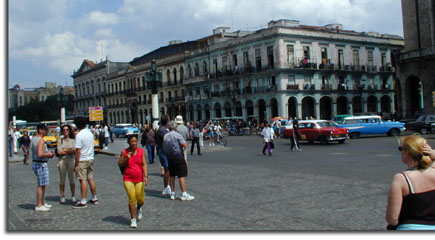 short
distance away. It was pretty amazing to think that just 90 miles
over the horizon, is a land and a culture that is so different from this
(and maybe not for the better). The city has flashes of color, but
is pretty gray and beat up. The government is pouring a lot of
money into restoration, but as we were to learn later, the government
owns all the land. You can buy a house, or build a hotel, but it
exists on government land. Even so, there were a lot
short
distance away. It was pretty amazing to think that just 90 miles
over the horizon, is a land and a culture that is so different from this
(and maybe not for the better). The city has flashes of color, but
is pretty gray and beat up. The government is pouring a lot of
money into restoration, but as we were to learn later, the government
owns all the land. You can buy a house, or build a hotel, but it
exists on government land. Even so, there were a lot
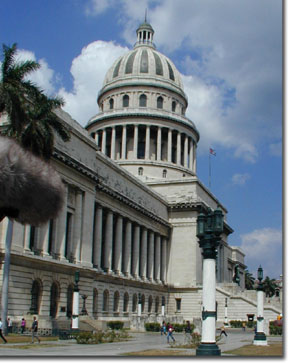 of
new fancy hotels, built with European money and really aimed at the
European tourist trade. We have seen very few Americans, and apparently,
they are a rarity. But there is no shortage of old American cars.
As I mentioned, this place is a gear head’s delight. Rumor has it
that under the hood of that '57 Chevrolet BelAir, may lay a Russian
engine. But there are some real finds here. Let’s face it.
The '53 Desoto was not exactly a collector item. But here they
are. Running around just like 1955. There are Buicks, Plymouth Furys,
Edsels, Cadillacs, Nash, Desoto, Chrysler, Dodge, Chevrolet, Ford,
Hudson, even '59 cat’s eye Chevys –
of
new fancy hotels, built with European money and really aimed at the
European tourist trade. We have seen very few Americans, and apparently,
they are a rarity. But there is no shortage of old American cars.
As I mentioned, this place is a gear head’s delight. Rumor has it
that under the hood of that '57 Chevrolet BelAir, may lay a Russian
engine. But there are some real finds here. Let’s face it.
The '53 Desoto was not exactly a collector item. But here they
are. Running around just like 1955. There are Buicks, Plymouth Furys,
Edsels, Cadillacs, Nash, Desoto, Chrysler, Dodge, Chevrolet, Ford,
Hudson, even '59 cat’s eye Chevys –
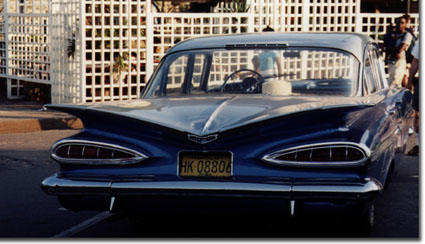 all
running as if it were 1960. True, some are rough. But some
are immaculate. It is quite a head turner for me. But I
belabor the point. We grabbed a taxi, and after two stops, managed to
find the Ministry of the Interior to see about extending our visas.
It seems that the date range is a window, and we have 30 days of stay
after entrance. It was NOT the International Press Center, which
we discovered later by accident. We made reservations at the
Novotel for the 17th, although Fernando (our guide) has to
call his agency and confirm the booking. So I feel better about
all that. Then we met a friend of Raul’s, Ania Rivera, who does
city tours. She spent the rest of the day with us (for a price –
and the price of a driver and minibus) and gave us a brief tour of the
all
running as if it were 1960. True, some are rough. But some
are immaculate. It is quite a head turner for me. But I
belabor the point. We grabbed a taxi, and after two stops, managed to
find the Ministry of the Interior to see about extending our visas.
It seems that the date range is a window, and we have 30 days of stay
after entrance. It was NOT the International Press Center, which
we discovered later by accident. We made reservations at the
Novotel for the 17th, although Fernando (our guide) has to
call his agency and confirm the booking. So I feel better about
all that. Then we met a friend of Raul’s, Ania Rivera, who does
city tours. She spent the rest of the day with us (for a price –
and the price of a driver and minibus) and gave us a brief tour of the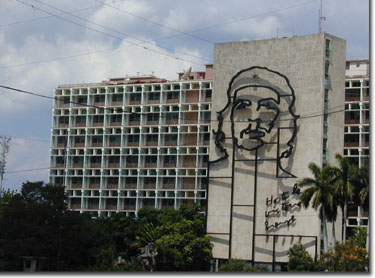 capitol, the revolutionary plaza, Old Havana, and the area around Moro
Castle (or fort). We lunched at a private home, which is licensed
as a small restaurant (called a paladar). The food was excellent,
but it was expensive. Remeber that we all had to take cash for
this trip, as credit cards from the United States won't work. At
this rate, I'll be destitute in no time.
capitol, the revolutionary plaza, Old Havana, and the area around Moro
Castle (or fort). We lunched at a private home, which is licensed
as a small restaurant (called a paladar). The food was excellent,
but it was expensive. Remeber that we all had to take cash for
this trip, as credit cards from the United States won't work. At
this rate, I'll be destitute in no time.
We headed back to the Old town section and got some shots of the street
life and the national band in concert. We shot one old woman, smoking a
cigar and generally acting as a tourist magnet. We walked though a
craft fair, saw a lot of old churches and office buildings, and then
headed back to the hotel. We went out to Moro Castle again to
shoot some of the shore drive, but most of the buildings fronting the
road are under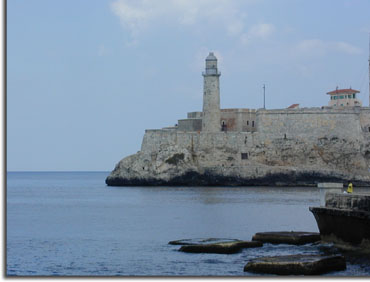 renovation, so lights were few. We came back to the hotel and got
the neon La Floridita sign popping on, and called it a day. We had
dinner at the hotel and the walked to another hotel for a coffee.
Jim is annoyed because all of the cigar shops are closed. My
impression is that there is a mystique to the place. But if it was
opened tomorrow, I don’t know how many Americans would be repeat
customers. There just isn’t yet enough here to hold a lot of
interest. American’s want amenities and things to do.
Perhaps the rest of the trip will change my mind. I shall see.
Havana has some Old Spanish charm, although most of it is in ill repair.
And it has some truly ugly buildings built by the Russians that are also
falling apart. It is interesting that since the Soviet Union
pulled all their support, the economy runs on the US dollar. You
may get some Cuban change (which off the island is worthless), but
dollars are the common currency.
renovation, so lights were few. We came back to the hotel and got
the neon La Floridita sign popping on, and called it a day. We had
dinner at the hotel and the walked to another hotel for a coffee.
Jim is annoyed because all of the cigar shops are closed. My
impression is that there is a mystique to the place. But if it was
opened tomorrow, I don’t know how many Americans would be repeat
customers. There just isn’t yet enough here to hold a lot of
interest. American’s want amenities and things to do.
Perhaps the rest of the trip will change my mind. I shall see.
Havana has some Old Spanish charm, although most of it is in ill repair.
And it has some truly ugly buildings built by the Russians that are also
falling apart. It is interesting that since the Soviet Union
pulled all their support, the economy runs on the US dollar. You
may get some Cuban change (which off the island is worthless), but
dollars are the common currency.
March 10
fter breakfast this morning, we
went to the revolutionary museum, which featured the history of Cuba
during and after Castro’s rise to power. I had my picture taken
next to the remains of Che Guevara, who is almost more revered than El
Jefe. We saw
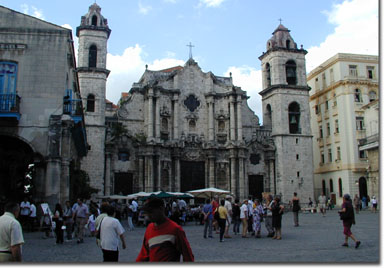 a
lot of pictures of dead guys, and read of the glories of the great
socialist state. Which got a little wearying after a while.
I wasn't allowed a close look at the aircraft missiles and the one prop
fighter plane, but did get to see the “Granma,” which – I found out
later – was the powerboat which brought an exiled Fidel and 18 of his
compatriots back to Cuba from Mexico. They landed in Granma
Province (southeastern end of the island) and proceeded to start the
revolution from there. We then headed for the market in Old
Havana, and while waiting for the crew to gather; I started a
conversation with a young street hustler named Tony. He was an
underwater welder by trade, and worked weekends trying to hustle
tourists in the market. He would peddle cigars, entrances to
palandars, restaurants, etc. He was 30, had been married 14 years,
and had two daughters, ages 10 and 12.
a
lot of pictures of dead guys, and read of the glories of the great
socialist state. Which got a little wearying after a while.
I wasn't allowed a close look at the aircraft missiles and the one prop
fighter plane, but did get to see the “Granma,” which – I found out
later – was the powerboat which brought an exiled Fidel and 18 of his
compatriots back to Cuba from Mexico. They landed in Granma
Province (southeastern end of the island) and proceeded to start the
revolution from there. We then headed for the market in Old
Havana, and while waiting for the crew to gather; I started a
conversation with a young street hustler named Tony. He was an
underwater welder by trade, and worked weekends trying to hustle
tourists in the market. He would peddle cigars, entrances to
palandars, restaurants, etc. He was 30, had been married 14 years,
and had two daughters, ages 10 and 12.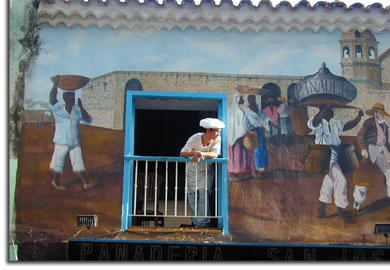 He made 350 pesos a month as a welder and supplemented it with this
activity. The monetary value in dollars is about $15 a month.
A cop makes around $30, doctors around $25, cab drivers about $40, and
teachers around $10-12. Each person is allocated food on a ration
system of 6 pounds each of sugar, rice, and flour. Meat is extra
and must be purchased for cash at the supermarket. Things are
available, but at a high price. He said that his parents
originally were from the eastern part lf the island, and had been very
wealthy, but while they were pretty unhappy, he was OK with things.
Life was difficult, but he did not seem morose of despondent over his
life here. He said he loved Cuba, and really didn’t want to live
anywhere else. He did point out a ferryboat that had been hijacked
to the US. It will be
He made 350 pesos a month as a welder and supplemented it with this
activity. The monetary value in dollars is about $15 a month.
A cop makes around $30, doctors around $25, cab drivers about $40, and
teachers around $10-12. Each person is allocated food on a ration
system of 6 pounds each of sugar, rice, and flour. Meat is extra
and must be purchased for cash at the supermarket. Things are
available, but at a high price. He said that his parents
originally were from the eastern part lf the island, and had been very
wealthy, but while they were pretty unhappy, he was OK with things.
Life was difficult, but he did not seem morose of despondent over his
life here. He said he loved Cuba, and really didn’t want to live
anywhere else. He did point out a ferryboat that had been hijacked
to the US. It will be
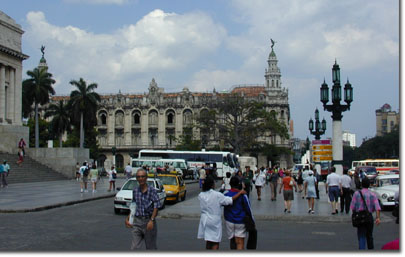 interesting
to see some of the outlying areas. We had a mojito on the roof of the
old American Embassy, and then headed back to the hotel through the
streets of Old Havana. The cigar hustlers and hookers were out in
droves today. But we made it back to hotel, took a nap, and then
went out to dinner a small Italian restaurant close to the hotel.
And then we waited for our Trains Unlimited Tours group to show, which
they did about 9:30. I think we will have to listen to a bunch of
revolutionary lectures, but such is the price of the trip.
interesting
to see some of the outlying areas. We had a mojito on the roof of the
old American Embassy, and then headed back to the hotel through the
streets of Old Havana. The cigar hustlers and hookers were out in
droves today. But we made it back to hotel, took a nap, and then
went out to dinner a small Italian restaurant close to the hotel.
And then we waited for our Trains Unlimited Tours group to show, which
they did about 9:30. I think we will have to listen to a bunch of
revolutionary lectures, but such is the price of the trip.
March 11
Today we are off to the main
station, to see the train from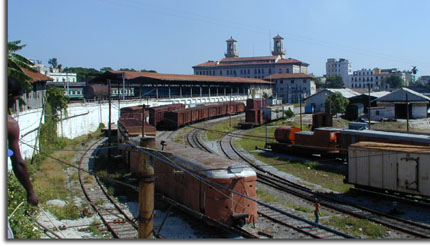 Santiago pulling in. Then it was off to the locomotive shops where
we were shut out. Lunch was in Old Havana – fortunately a place we
had not already eaten. Then we were lead to the passenger car
shop, where saw only self-propelled Russian rail
Santiago pulling in. Then it was off to the locomotive shops where
we were shut out. Lunch was in Old Havana – fortunately a place we
had not already eaten. Then we were lead to the passenger car
shop, where saw only self-propelled Russian rail
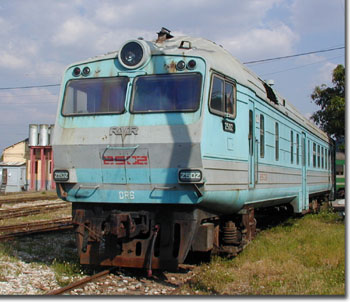 car
in the country. All the passenger cars look grim, caked with dirt
and generally beat up. Then it was back to Old Havana, and a stop
at the Hotel International, were I saw another mint '59 Chevrolet
Impala. Finally it was back to our hotel for an educational
meeting, two interviews, and dinner. My phone card won't work in
this area code. I was sooo surprised!
car
in the country. All the passenger cars look grim, caked with dirt
and generally beat up. Then it was back to Old Havana, and a stop
at the Hotel International, were I saw another mint '59 Chevrolet
Impala. Finally it was back to our hotel for an educational
meeting, two interviews, and dinner. My phone card won't work in
this area code. I was sooo surprised!
March 12
We got out of the hotel at about
9 AM, after having to fight our way up to breakfast, the elevators were
all locked out of the fifth floor. Instead of the water ferry, we
drove over across the bay via a tunnel to Casablanca, which was the end
of the line for the
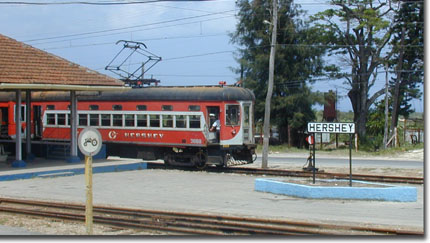 Hershey
electric line. We boarded two old Brill cars, and headed east to
Hershey and Matanzas. It was very crowded, as there are 68 people
on this trip, which is a tad to many, in my opinion. And these are
serious rail fans. We did a couple of run bys, and ended up in the
shops in Hershey, which was also part of a sugar mill. There was
no steam here, but we did see old GE box cab electrics hauling cane
cars. I had wanted to do a short standup with one of the tour
director, but he was ill, and we had to put it off. We, along with
about 8 other people, bailed on the rest of the Brill car ride and took
the bus to
Hershey
electric line. We boarded two old Brill cars, and headed east to
Hershey and Matanzas. It was very crowded, as there are 68 people
on this trip, which is a tad to many, in my opinion. And these are
serious rail fans. We did a couple of run bys, and ended up in the
shops in Hershey, which was also part of a sugar mill. There was
no steam here, but we did see old GE box cab electrics hauling cane
cars. I had wanted to do a short standup with one of the tour
director, but he was ill, and we had to put it off. We, along with
about 8 other people, bailed on the rest of the Brill car ride and took
the bus to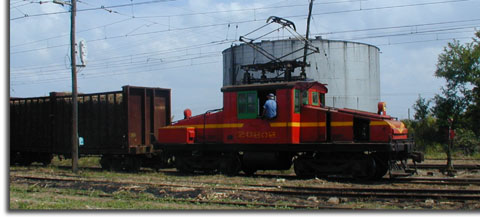 Veradero. The land is very pretty, with rolling hills and farm
plots. Everything is pretty green, and it was even better as we
used the road along the north coast. Veradero is a resort area,
and our hotel is quite nice. The bellman told me that in the
summer it could get as high as 40C (112F) degrees here. This
would not be to my liking. The resort is all-inclusive, and we had
a few drinks by the pool and dinner. Jim and I walked around a
little bit. This is cleaner and better kept than Havana. We saw a
lot of people visiting, playing with their kids – one father and
daughter flying a plastic grocery bag! Everyone was friendly and
spoke to us. Wanted to know where we were from, etc.
Everyone thinks we are Canadian, and are surprised to learn that we are
from the USA. Enough. Tomorrow we are back on steam, and
several sugar mills. And back to Havana and the Plaza Hotel.
Veradero. The land is very pretty, with rolling hills and farm
plots. Everything is pretty green, and it was even better as we
used the road along the north coast. Veradero is a resort area,
and our hotel is quite nice. The bellman told me that in the
summer it could get as high as 40C (112F) degrees here. This
would not be to my liking. The resort is all-inclusive, and we had
a few drinks by the pool and dinner. Jim and I walked around a
little bit. This is cleaner and better kept than Havana. We saw a
lot of people visiting, playing with their kids – one father and
daughter flying a plastic grocery bag! Everyone was friendly and
spoke to us. Wanted to know where we were from, etc.
Everyone thinks we are Canadian, and are surprised to learn that we are
from the USA. Enough. Tomorrow we are back on steam, and
several sugar mills. And back to Havana and the Plaza Hotel.
March 13
We headed out this morning via
bus to a sugar mill named Jose
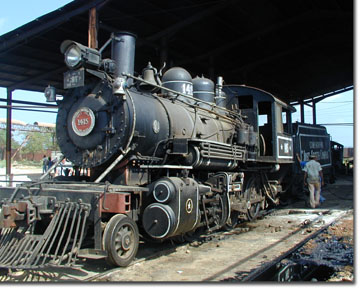 Comas.
And true to the ads, they were running old Baldwin locos. Steam at
last. The trains would haul the cane out of the fields to the
mill. As usual, everything looked pretty run down. But
it all still works. It is rather strange watching a guy plow a
field with an ox team. We did a number of run bys at the mill,
which took forever. And it was hot and dusty. If it hadn’t been for the
breeze, it would have been a lot worse. Around Noon, we hopped back on
the buses and headed for the Cuba Libre sugar mill, which was a larger
Comas.
And true to the ads, they were running old Baldwin locos. Steam at
last. The trains would haul the cane out of the fields to the
mill. As usual, everything looked pretty run down. But
it all still works. It is rather strange watching a guy plow a
field with an ox team. We did a number of run bys at the mill,
which took forever. And it was hot and dusty. If it hadn’t been for the
breeze, it would have been a lot worse. Around Noon, we hopped back on
the buses and headed for the Cuba Libre sugar mill, which was a larger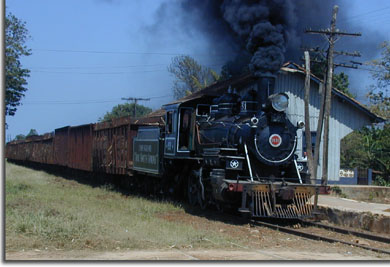 and seemingly more prosperous enterprise. They too, were still
using Baldwin 2-6-0 to haul the cane around. They also had a
rotary dumper, which cost me about 10 bucks in “licensing fees” to
shoot. Everyone here has “dollar fever.” We got a standup
with the tour director done, and hopped on two passenger cars in a mixed
consist with double headed steam for more run bys. The land is
pretty flat and agricultural, and as I said, it was quite something to
see an old man driving a horse cart, with his dog by is side, as we rode
through the cane fields. We have passed through many small towns,
and everyone turns out to see the train. There is a lot of
colonial architecture, which is just beautiful, but is in poor repair.
It would take billions to bring this place up to an American standard.
But I guess that is a poor way
and seemingly more prosperous enterprise. They too, were still
using Baldwin 2-6-0 to haul the cane around. They also had a
rotary dumper, which cost me about 10 bucks in “licensing fees” to
shoot. Everyone here has “dollar fever.” We got a standup
with the tour director done, and hopped on two passenger cars in a mixed
consist with double headed steam for more run bys. The land is
pretty flat and agricultural, and as I said, it was quite something to
see an old man driving a horse cart, with his dog by is side, as we rode
through the cane fields. We have passed through many small towns,
and everyone turns out to see the train. There is a lot of
colonial architecture, which is just beautiful, but is in poor repair.
It would take billions to bring this place up to an American standard.
But I guess that is a poor way
 of
looking at it all. We ended our train ride – very plain coaches
and sun blasted window laminate- and we going to do another run by at
the station, but the train had a car derail. So we are headed back
to Havana by bus on (initially) really bad roads. As it got dark
we could see the cane fields being burned off, which made for
spectacular fires. We finally hit a freeway, and pulled into the
Plaza in Havana about 8 PM. There was the usual screw up at the
desk with 70+ people all trying to get checked in. Everyone is hot
and tired and dirty. We just headed up for dinner and then back
toe room. My room is a definite improvement over the last one.
The A/C works well, and it is quiet. It is unfortunate that we are
out of here so early tomorrow. As a final note, the tour director
found his lost person. The guy wandered off in Hershey, missed the
bus, and took his own little tour. First he went to Veradero, got the
wrong hotel and then made his way back here. I think children are
easier to deal with than rail fans. At least children listen.
Rail fans see a train and just are lost to time and place.
of
looking at it all. We ended our train ride – very plain coaches
and sun blasted window laminate- and we going to do another run by at
the station, but the train had a car derail. So we are headed back
to Havana by bus on (initially) really bad roads. As it got dark
we could see the cane fields being burned off, which made for
spectacular fires. We finally hit a freeway, and pulled into the
Plaza in Havana about 8 PM. There was the usual screw up at the
desk with 70+ people all trying to get checked in. Everyone is hot
and tired and dirty. We just headed up for dinner and then back
toe room. My room is a definite improvement over the last one.
The A/C works well, and it is quiet. It is unfortunate that we are
out of here so early tomorrow. As a final note, the tour director
found his lost person. The guy wandered off in Hershey, missed the
bus, and took his own little tour. First he went to Veradero, got the
wrong hotel and then made his way back here. I think children are
easier to deal with than rail fans. At least children listen.
Rail fans see a train and just are lost to time and place.
March 14
I had breakfast with a delightful
couple from Hattiesburg, Mississippi. She was very much the
Southern woman – steel
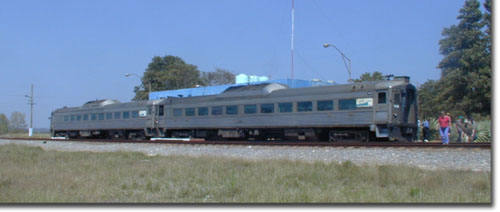 wrapped
in warm velvet. I think we shall interview them, as rather
than being rabid rail fans, they just like to ride trains. We were
late getting to Havana’s Central Station (no surprise) and found the
Budd cars in place. It seems that a wreck on the main line
compromised the original plan for today. So we are trying to do
Friday, today. We did one run by with the RDCs, and otherwise just
pounded down miles to Moron, which is pretty much in the center of the
island. The A/C is in bad shape, and as the windows are sealed, it
is hot, hot. Pretty much everyone is asleep. We ran through
some small coastal mountains. and are
wrapped
in warm velvet. I think we shall interview them, as rather
than being rabid rail fans, they just like to ride trains. We were
late getting to Havana’s Central Station (no surprise) and found the
Budd cars in place. It seems that a wreck on the main line
compromised the original plan for today. So we are trying to do
Friday, today. We did one run by with the RDCs, and otherwise just
pounded down miles to Moron, which is pretty much in the center of the
island. The A/C is in bad shape, and as the windows are sealed, it
is hot, hot. Pretty much everyone is asleep. We ran through
some small coastal mountains. and are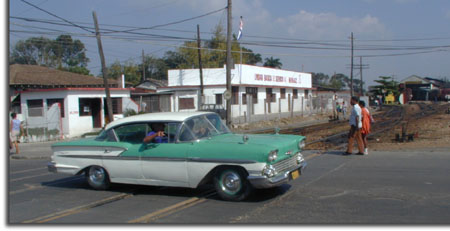 now off in flat agricultural plains again. It has been so hot on
the trip. Sealed units are fine, when the A/C works. But it
is just miserable when it doesn’t. We finally propped the doors
open for the movement of some air. The Cuban railroad is in great
shape. The use of concrete sleepers helps, and the track is smooth
and level. The engineer got these old RDC's going flat out.
At one point the speedometer read 150 kilometers per hour, which I think
is around 92 miles per hour. Whatever the speed, we were really
hauling. After several stops we arrived in Moron. Rather
than wait
now off in flat agricultural plains again. It has been so hot on
the trip. Sealed units are fine, when the A/C works. But it
is just miserable when it doesn’t. We finally propped the doors
open for the movement of some air. The Cuban railroad is in great
shape. The use of concrete sleepers helps, and the track is smooth
and level. The engineer got these old RDC's going flat out.
At one point the speedometer read 150 kilometers per hour, which I think
is around 92 miles per hour. Whatever the speed, we were really
hauling. After several stops we arrived in Moron. Rather
than wait
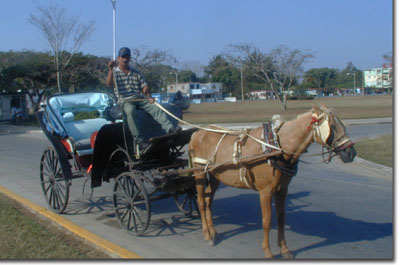 for
the second bus to ferry us from the station to the hotel, we took a
horse drawn carriage. The hotel is nice, and I lucked into a
suite. Cuba is interesting. It is a land struggling to get
by in whatever way it can. The people are friendly and pleasant to
be around. There are reports of some crime, but the crime rate is
still very low. Everyone is hustling. I read an article in
the Washington Post (I think) in which the author was traveling with a
Cuban traveler in Mexico City. They were passing down a street,
which was filled with KFC, McDonalds, Pizza Hut, etc. The author
asked the Cuban if this is what the Cuban people were afraid would
happen when Fidel dies. The Cuban answered, “You don’t understand.
This is what we want.” There will be changes here. In
reading some history of the island, I think that the Cuban national
spirit will prevail, whatever the changes of time will bring.
for
the second bus to ferry us from the station to the hotel, we took a
horse drawn carriage. The hotel is nice, and I lucked into a
suite. Cuba is interesting. It is a land struggling to get
by in whatever way it can. The people are friendly and pleasant to
be around. There are reports of some crime, but the crime rate is
still very low. Everyone is hustling. I read an article in
the Washington Post (I think) in which the author was traveling with a
Cuban traveler in Mexico City. They were passing down a street,
which was filled with KFC, McDonalds, Pizza Hut, etc. The author
asked the Cuban if this is what the Cuban people were afraid would
happen when Fidel dies. The Cuban answered, “You don’t understand.
This is what we want.” There will be changes here. In
reading some history of the island, I think that the Cuban national
spirit will prevail, whatever the changes of time will bring.
March 15
We hit breakfast and then did a
short interview with the Hattiesburg couple (Mary (Widgie) and J.C.
Bell) at the pool. We then grabbed two horse drawn carriages and shot a
tour of Moron, with some architectural footage (crumbling colonial) and
ugly Russian concrete housing boxes. John and Gail went off on
their own, and Jim and I got some water in a local store. We then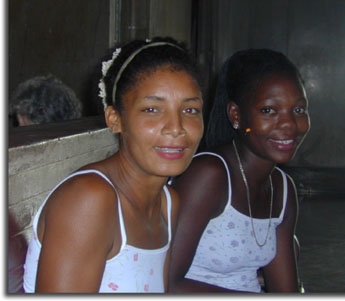 waited in the station and got accosted by three young women, who just
wanted to talk and have a good time. My Spanish is terrible.
Non-existent, really. So it was a struggle. Jim started to
feel rather unwell, and so he begged off on today’s trip and stayed
close to more up to date facilities here at the hotel. It is just
as well he did, because the charter train consisted of former Romanian
boxcars, which had been converted to local passenger service. They
were a little short on comfort, ride, and
waited in the station and got accosted by three young women, who just
wanted to talk and have a good time. My Spanish is terrible.
Non-existent, really. So it was a struggle. Jim started to
feel rather unwell, and so he begged off on today’s trip and stayed
close to more up to date facilities here at the hotel. It is just
as well he did, because the charter train consisted of former Romanian
boxcars, which had been converted to local passenger service. They
were a little short on comfort, ride, and
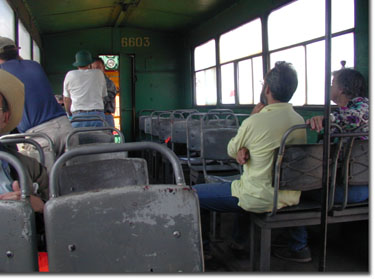 any
other amenities. We slowly made our way to Ciego de Avila, which
was a distance of about 60 Km. The station had a double diamond
cross over right in the middle. This is unusual, to say the least.
We saw a local school, and one of the train crew, and Michel Martinez,
said that we could talk to the children, and see some of the school.
And then we ran up against the principal, who accused us of being with
the CIA, blah, blah, blah, blah. The guy was most apoplectic.
But principals are the same in Cuba as in the US. They
any
other amenities. We slowly made our way to Ciego de Avila, which
was a distance of about 60 Km. The station had a double diamond
cross over right in the middle. This is unusual, to say the least.
We saw a local school, and one of the train crew, and Michel Martinez,
said that we could talk to the children, and see some of the school.
And then we ran up against the principal, who accused us of being with
the CIA, blah, blah, blah, blah. The guy was most apoplectic.
But principals are the same in Cuba as in the US. They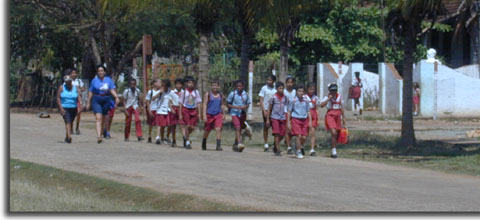 run their own little fiefdoms. So we shot what we could, and moved
on. In talking to Michel, he said that he was almost finished with
is degree in what turned out to be computers, and was working for the
railroad on their signaling systems (FerroCarriel de Cuba - FdeC- still
does not have ATC). He had to work for two years for 200 pesos a
month once he graduated, as payback for his state funded schooling.
I didn’t want to get into a debate about they pay/you pay back vs. you
pay/pay them back school loans, etc. He was interesting to talk to
and once we discovered our mutual attraction to computers, just kept at
it. He told me that in all of Cuba there is one copy of Windows 2000
Professional, and one copy of 2000 Advanced Server. He said every one
knows the key code, as they have been duplicating it like crazy.
But, he shrugged, the US has us under embargo, and so what can Microsoft
do? He said that when the embargo is lifted, they are all dead
(figuratively). It just goes to show the ingenuity of these
people. Who, by the way, are making great strides in the
development of vaccinations (which I read).
run their own little fiefdoms. So we shot what we could, and moved
on. In talking to Michel, he said that he was almost finished with
is degree in what turned out to be computers, and was working for the
railroad on their signaling systems (FerroCarriel de Cuba - FdeC- still
does not have ATC). He had to work for two years for 200 pesos a
month once he graduated, as payback for his state funded schooling.
I didn’t want to get into a debate about they pay/you pay back vs. you
pay/pay them back school loans, etc. He was interesting to talk to
and once we discovered our mutual attraction to computers, just kept at
it. He told me that in all of Cuba there is one copy of Windows 2000
Professional, and one copy of 2000 Advanced Server. He said every one
knows the key code, as they have been duplicating it like crazy.
But, he shrugged, the US has us under embargo, and so what can Microsoft
do? He said that when the embargo is lifted, they are all dead
(figuratively). It just goes to show the ingenuity of these
people. Who, by the way, are making great strides in the
development of vaccinations (which I read).
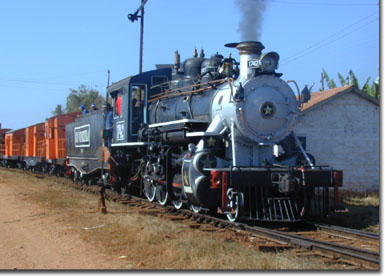 Then
it was on to the Venezuelan sugar mill, where they were still running
steam. After we poked around the workshops a bit – where they had
several steam locos under repair – we hopped on a 2-8-0 Baldwin for a
ride back to Ciego de Avila and return to the mill. Enroute we
picked up about 18 loaded cane cars. We had several nice run bys,
with the engine really working. On one of the run bys, the
engine’s whistle spooked a horse carriage, which in turn ran over a
Then
it was on to the Venezuelan sugar mill, where they were still running
steam. After we poked around the workshops a bit – where they had
several steam locos under repair – we hopped on a 2-8-0 Baldwin for a
ride back to Ciego de Avila and return to the mill. Enroute we
picked up about 18 loaded cane cars. We had several nice run bys,
with the engine really working. On one of the run bys, the
engine’s whistle spooked a horse carriage, which in turn ran over a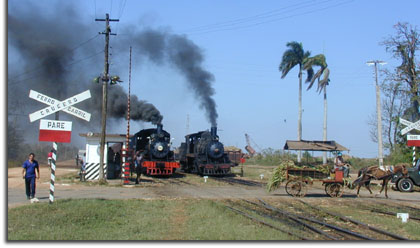 bicyclist. No one was hurt, but we have it on tape. We got
some great footage in a golden late afternoon light, and then, given the
choice between riding the bus back to Moron or the train, everyone
bolted for the bus. Free money wouldn’t have moved this crowd any
faster. We got back to the hotel, showered, had dinner, and got
ourselves mentally prepared for the long, hot ride back to Havana
tomorrow.
bicyclist. No one was hurt, but we have it on tape. We got
some great footage in a golden late afternoon light, and then, given the
choice between riding the bus back to Moron or the train, everyone
bolted for the bus. Free money wouldn’t have moved this crowd any
faster. We got back to the hotel, showered, had dinner, and got
ourselves mentally prepared for the long, hot ride back to Havana
tomorrow.
March 16
Last night the hotel was overrun
with German tourists, who kept the disco hopping until 2. And they
overloaded the breakfast facilities to the point where I didn’t get any
coffee. As I got back to the room, the maid, who kept trying to
tell me something in Spanish. Fortunately one of the tour
directors came along and after a torrent of Spanish, simply laughed and
said, “Pay for your laundry at the front desk.” We were ready for
a hot and steamy ride back to Havana. Rather than wait for the
buses, we followed
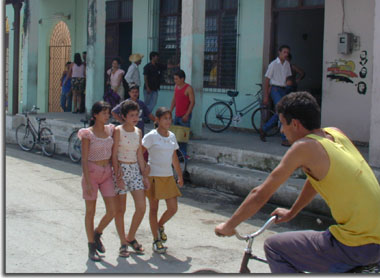 the
old rail fan trick of grabbing horse drawn cabs to he station, and
nabbed seats (on the wrong side again) before the rest of the group
showed up. The cars were delightfully cool, which only lasted
about two hours into the day. About twenty people opted to take
the bus back, so it was a little less crowded than on the way out.
I promptly fell asleep, and the crew amused themselves by taping me
snoring and tickling my nose. I’m sure the tape will show up at
very inopportune times. We did a couple of run bys, one in a small
town. Everyone is so friendly and cheerful. And they are glad to
hear we are from the US. I definitely wish I had brought pens,
instead of pins, but the children like the latter. The kids are
all so cute. We just kept
the
old rail fan trick of grabbing horse drawn cabs to he station, and
nabbed seats (on the wrong side again) before the rest of the group
showed up. The cars were delightfully cool, which only lasted
about two hours into the day. About twenty people opted to take
the bus back, so it was a little less crowded than on the way out.
I promptly fell asleep, and the crew amused themselves by taping me
snoring and tickling my nose. I’m sure the tape will show up at
very inopportune times. We did a couple of run bys, one in a small
town. Everyone is so friendly and cheerful. And they are glad to
hear we are from the US. I definitely wish I had brought pens,
instead of pins, but the children like the latter. The kids are
all so cute. We just kept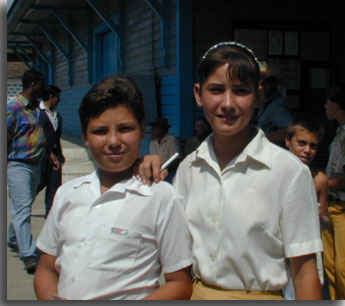 hammering away on the miles until we hit km post 170 east of Havana.
Every rail trip must have an adventure, and this was no exception.
The disk brake rotor on the front truck broke away. After much
debate, and numerous suggestions from the fans on what to so, the rail
crew uncoupled the second car, which only had one operating
transmission, and we all climbed on board and headed for Havana.
It was hot. Oh my, but it was hot. The rail crew went as
fast as they could, and finally threw caution to the winds and fired up
the second engine, put it on line, and ran us (despite the engine
warnings) at 80 km per hour into the closest station in Havana. We
headed back to the Plaza Hotel (another good room), peeled our clothes
off, took showers, and went up to dinner. By the time we arrived,
things were a little bare, but they did have lots a rabbit, which was
very good. I did go across the street to the next hotel, and established
that they have Internet access from 8-8. Perhaps I shall try first
thing in the morning when traffic should be light. We have two
interviews to do, starting at 9:30.
hammering away on the miles until we hit km post 170 east of Havana.
Every rail trip must have an adventure, and this was no exception.
The disk brake rotor on the front truck broke away. After much
debate, and numerous suggestions from the fans on what to so, the rail
crew uncoupled the second car, which only had one operating
transmission, and we all climbed on board and headed for Havana.
It was hot. Oh my, but it was hot. The rail crew went as
fast as they could, and finally threw caution to the winds and fired up
the second engine, put it on line, and ran us (despite the engine
warnings) at 80 km per hour into the closest station in Havana. We
headed back to the Plaza Hotel (another good room), peeled our clothes
off, took showers, and went up to dinner. By the time we arrived,
things were a little bare, but they did have lots a rabbit, which was
very good. I did go across the street to the next hotel, and established
that they have Internet access from 8-8. Perhaps I shall try first
thing in the morning when traffic should be light. We have two
interviews to do, starting at 9:30.
March 17
I was up early and out to
breakfast today. The place is pretty over-run with tourists.
I wanted to get to the hotel across the
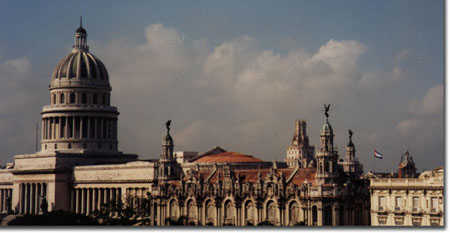 street
right at 8 AM for Internet access. I got there at one minute past
eight, and found three of the tour group already there. I did
manage to wait long enough to get in about 30 minutes, which cost about
$7. I headed back to the hotel, for another interview, this time
with tour operator, Chris Skow. We put the Cuban capitol in the
background, and it really looked nice. It was very hot, but the
interview went well. Chris has been running the train tours since
the mid 1980’ and does – in my opinion – a superb job. We then
headed down to the tea garden and did an interview with the people from
northern Wisconsin. They did well also, and then we had a sit down
meeting with our hired guides concerning the rest of the trip. We
got things pretty well lined up, and headed off for the Novotel for
check-in. The motel is great. It is much better than anyplace we
have stayed in the last week. In fact, it was suggested that we
blow off the rest of the week and just hang out here, working on our
tans. We barely had time to dump our gear, before we had to get
back to the group for a tour of the shops. That took pretty much
the rest of the afternoon, and we had time to do some stand-ups with Jim
on the Plaza roof before we headed back to the hotel, show, and go to a
departure dinner. You meet some great people on these trips, and
are sorry to see many of them leave. I am sure we will run across
some of these people again. We then sat around the pool, and had a
beer, before turning in.
street
right at 8 AM for Internet access. I got there at one minute past
eight, and found three of the tour group already there. I did
manage to wait long enough to get in about 30 minutes, which cost about
$7. I headed back to the hotel, for another interview, this time
with tour operator, Chris Skow. We put the Cuban capitol in the
background, and it really looked nice. It was very hot, but the
interview went well. Chris has been running the train tours since
the mid 1980’ and does – in my opinion – a superb job. We then
headed down to the tea garden and did an interview with the people from
northern Wisconsin. They did well also, and then we had a sit down
meeting with our hired guides concerning the rest of the trip. We
got things pretty well lined up, and headed off for the Novotel for
check-in. The motel is great. It is much better than anyplace we
have stayed in the last week. In fact, it was suggested that we
blow off the rest of the week and just hang out here, working on our
tans. We barely had time to dump our gear, before we had to get
back to the group for a tour of the shops. That took pretty much
the rest of the afternoon, and we had time to do some stand-ups with Jim
on the Plaza roof before we headed back to the hotel, show, and go to a
departure dinner. You meet some great people on these trips, and
are sorry to see many of them leave. I am sure we will run across
some of these people again. We then sat around the pool, and had a
beer, before turning in.
March 18
We all got up late and fought
with the crowds for breakfast. This may be a better hotel, but it
pretty much a tourist factory. And if you are familiar with
Novotel, you know they are a French outfit. It is geared to
serving large groups – very large groups. Normally, this is the
kind of place I shy away from. It lacks the charm of the Plaza,
but has much nicer amenities. Like the fact that all the light
bulbs function, and all the plumbing pieces function as they should.
In true French fashion it is wired for 220, so I’m glad my hair dryer
and computer charger are dual voltage. I went to the hotel stores
and bought a polo and T shirt, as well as the requisite refrigerator
magnets. I also bought a box of ten cigars and a bottle of
seven-year-old rum, which is kind of odd, as I don’t smoke and really
don’t drink rum. But I figured if I’m in Cuba, everyone will ask if I
brought any of that stuff back. As a journalist, I am supposed to be able to bring back $100 of stuff.
We shall see. After laying in the sun – real easy to get scorched
– and drying my socks at the same time, we headed for the Hotel National
de Cuba, and an interview in the bar with a local singer who is
apparently a very big deal here- Carlos Verela. He is apparently
internationally known, and sings songs, which are protest songs of the
Cuban government. But he is pretty much left alone. He was
initially a little hesitant, but Jim brought him out (took 40 minutes of
tape) and he warmed up. It was a good interview with thoughts on
his love for Cuba and the Cuban people. He said – and I would
agree from my short, short time - that when Fidel dies, it really won’t
change too much. Leave these people alone with their system of
choice, set up some trade, and move on. If people want to leave,
they will find a way. Twenty thousand leave every year as a result
of the lottery, in which over a tenth of the population participates.
On the way back from the interview we stopped at a little flea market
that I have been eyeing for the last week. I bought some old Cuban
stamps, and browsed through some old books. Old books seem to sell
here, and there was a copy of HG Wells and Jules Verne in Spanish.
And of course the usual Che and revolutionary books (the life of Lenin,
that sort of thing).
journalist, I am supposed to be able to bring back $100 of stuff.
We shall see. After laying in the sun – real easy to get scorched
– and drying my socks at the same time, we headed for the Hotel National
de Cuba, and an interview in the bar with a local singer who is
apparently a very big deal here- Carlos Verela. He is apparently
internationally known, and sings songs, which are protest songs of the
Cuban government. But he is pretty much left alone. He was
initially a little hesitant, but Jim brought him out (took 40 minutes of
tape) and he warmed up. It was a good interview with thoughts on
his love for Cuba and the Cuban people. He said – and I would
agree from my short, short time - that when Fidel dies, it really won’t
change too much. Leave these people alone with their system of
choice, set up some trade, and move on. If people want to leave,
they will find a way. Twenty thousand leave every year as a result
of the lottery, in which over a tenth of the population participates.
On the way back from the interview we stopped at a little flea market
that I have been eyeing for the last week. I bought some old Cuban
stamps, and browsed through some old books. Old books seem to sell
here, and there was a copy of HG Wells and Jules Verne in Spanish.
And of course the usual Che and revolutionary books (the life of Lenin,
that sort of thing).
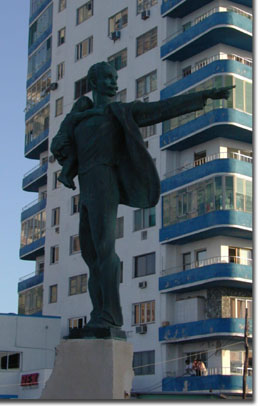 We
tried to get a shot of the “Elian you idiot” statue, but were told it
was “top secret.” I think the monument is very funny. It was
erected after the return to Cuba of Elian Gonzales, and shows the boy
being carried by José Marti (gee, who else?). Jose has his arm
outstretched and pointing. Since the pointing arm is roughly in a
westerly direction, the Cubans interpret that the statue as Jose saying,
“Elian, you idiot. Miami is that way!” Back to the hotel for
dinner and a boatload of tourists. Then off to the Parisian where
we were supposed to shoot some of the floor show. However, our
filming permits have not materialized so it was a bust. The hotel
also took a power hit and fried both our power converters, so we were
afraid the charger was dead as well. Fortunately it still works on
110. Who but the French would build a hotel that only runs 220 in a land
of otherwise 110 AC.
We
tried to get a shot of the “Elian you idiot” statue, but were told it
was “top secret.” I think the monument is very funny. It was
erected after the return to Cuba of Elian Gonzales, and shows the boy
being carried by José Marti (gee, who else?). Jose has his arm
outstretched and pointing. Since the pointing arm is roughly in a
westerly direction, the Cubans interpret that the statue as Jose saying,
“Elian, you idiot. Miami is that way!” Back to the hotel for
dinner and a boatload of tourists. Then off to the Parisian where
we were supposed to shoot some of the floor show. However, our
filming permits have not materialized so it was a bust. The hotel
also took a power hit and fried both our power converters, so we were
afraid the charger was dead as well. Fortunately it still works on
110. Who but the French would build a hotel that only runs 220 in a land
of otherwise 110 AC.
March 19
We rolled out of the hotel at
8:30 and headed straight for the press office. Wonder of wonders,
we had our credentials in about fifteen minutes. And the office
relieved us of $61 each for the privilege. If I had any advice to
give to anyone coming here, it would be to bring lots of cash. No, bring
a truckload of cash. In a cash economy, you can roll through money like
there is no tomorrow. And everyone has his hand out. We
headed down to Pinar del Rio, which is a very pretty area. We will
continue to Vinales, which is even hillier. We ran into some rain,
and it looks as if we will fight tropical showers all day. I am
seriously out of money, as is Jim. Our guide is out, and everybody
is mad at everybody. At least Jim and I are still speaking.
We got to Pinar del Rio, which is kind of a neat little town and went to
the prearranged tour of the cigar factory. The tour was now off.
Then it was on, then it was off unless we paid, then it was on for only
the non-professional camera, then it was on for all cameras but only for
15 minutes. It still cost $5 per head. But that was only for
the factory, where assembly line techniques churn out the cigars.
At the retail shop, we could talk with a single hand roller and shoot as
long as we liked for free. We took advantage of it and got a nice
interview. Then we headed out to the tobacco fields and found some
guys cutting and drying the tobacco leaves.
 Jim
did another nice interview and then the farmers wife took us on a tour
of their home. It was pretty humble. He farmer said that he is a
third generation tobacco farmer and that he had been to the city, but it
scared him. He liked it in the country. I think this segment will
be great if the rest of the interviews go as well
Jim
did another nice interview and then the farmers wife took us on a tour
of their home. It was pretty humble. He farmer said that he is a
third generation tobacco farmer and that he had been to the city, but it
scared him. He liked it in the country. I think this segment will
be great if the rest of the interviews go as well
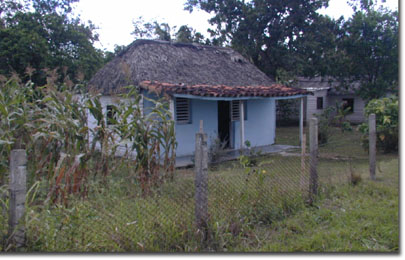 as
the last couple. On the other hand, Estavio Leal wants a thousand
dollars for his interview tomorrow. We are going to show up on his
doorstep and see if we can schmooze him. I am trying to get my
plane tickets changed and leave early. We are so cash short, that
one less body will help. I need to get back o the US and get to an ATM.
Our guide was correct in that we would not be as fortunate with dinner
as the previous night. So there goes another thirty dollars.
Lack of cash sure slows one down. There are bad, bad rainstorms in
the area and power hits on the hotel. We are back to 110 VAC and a
hit takes out the charger. Isn't that special.
as
the last couple. On the other hand, Estavio Leal wants a thousand
dollars for his interview tomorrow. We are going to show up on his
doorstep and see if we can schmooze him. I am trying to get my
plane tickets changed and leave early. We are so cash short, that
one less body will help. I need to get back o the US and get to an ATM.
Our guide was correct in that we would not be as fortunate with dinner
as the previous night. So there goes another thirty dollars.
Lack of cash sure slows one down. There are bad, bad rainstorms in
the area and power hits on the hotel. We are back to 110 VAC and a
hit takes out the charger. Isn't that special.
March 20
Where has the month gone? By the
way, did I mention the Russian Embassy? I am sorry that I did not
take a photo of it, because it is truly ugly and out of place in Havana.
Rather than conform to the graceful lines of colonial architecture, the
Russians built this 5 story concrete monolith on the beach. And
then added a square spire of at least another three stories.
Yikes. What a horrible, horrible thing. It is just so – um,
“Soviet!” People here just shake their heads in dismay. We
were up and out early –even before breakfast, and on the road to Havana.
The roads were still wet, but we were ahead of the tourist buses and all
the Kamas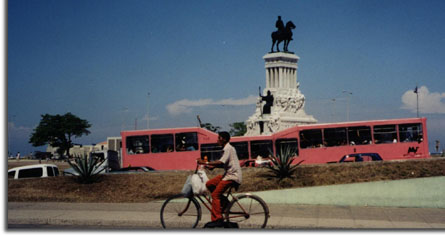 Transporters. Those things were not built to any air pollution
standards, except to pour out as many unburned diesel hydrocarbons as
possible. We showed up at Estavio Leal’s office promptly at 9 AM.
And sure enough, we did get an interview. Actually, getting him to
not talk was more the issue. This is going to be a great story
that Jim is getting together. An amusing part is that John, the
cameraman,
Transporters. Those things were not built to any air pollution
standards, except to pour out as many unburned diesel hydrocarbons as
possible. We showed up at Estavio Leal’s office promptly at 9 AM.
And sure enough, we did get an interview. Actually, getting him to
not talk was more the issue. This is going to be a great story
that Jim is getting together. An amusing part is that John, the
cameraman,
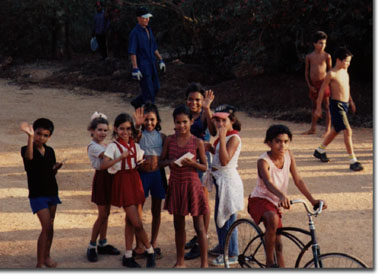 and
the only one with any cash left, had to make a donation of $200 to the
“Save Havana” fund. We are all still laughing – well, except John.
Then it was off to the Partegas Cigar factory, where we did more
interviews with cigar makers. It was- in my opinion – just OK, as
it duplicated what we saw yesterday. And then, it was back to the
French at the Novotel. We still have no money. Later.
I was able to change my Air Jamaica tickets to tomorrow. So I
shall be leaving early, mostly to conserve money.
and
the only one with any cash left, had to make a donation of $200 to the
“Save Havana” fund. We are all still laughing – well, except John.
Then it was off to the Partegas Cigar factory, where we did more
interviews with cigar makers. It was- in my opinion – just OK, as
it duplicated what we saw yesterday. And then, it was back to the
French at the Novotel. We still have no money. Later.
I was able to change my Air Jamaica tickets to tomorrow. So I
shall be leaving early, mostly to conserve money.
March 21
After a restless night, I got up at a quarter to six for my 9:15 flight. I checked out and owed 30 cents. For what, I have no idea. I got to Jose Marti Airport about 7 AM, and had to wait for about a half hour for the Air Jamaica people to show up. But I wasn’t alone. The monitor showed the flight on time at 9:15, but 9:15 came and went. I asked one of the other passengers in the waiting area, and we checked our tickets and they said 10:15. You check the monitor, and then the boarding pass is different. I can’t win. We had an uneventful flight to Kingston and then Montego Bay. However, I sat, and sat, and sat in Montego Bay. Unless you go down to the duty-free shops, you have to sit in this long aisle. It is uncomfortable, but a great place to people watch. And the flight was first pushed back twenty-five minutes, then an hour, and finally and hour and a half. The Jamaican security had to search the luggage by hand, even though I was a passenger in transit. And the skies kept getting darker and darker with storms. But we finally got off, an hour and a half late, and arrived uneventfully in Miami. I put on my customs declaration that I had been to Montego Bay and Cuba, and that I had a box of cigars and a bottle of rum. After a lengthy wait (45 minutes) for the luggage, the customs guys didn’t even blink. And I purposely left the Cuban transfer tags on my bag. So I’m back. I’m checking into a motel (Hampton has a shuttle and gives me points) and then I’m going to find a big, greasy cheap cheeseburger. I’ll pay later in indigestion, but that sure sounds good. Tomorrow I’ll see if I can get a gate agent from Northwest to take pity on me and move my flight up. And I’ll find an ATM.
March 22
I called the airline, and I can
get out on the same flights, but not until tomorrow. It seems that
Spring break has things pretty well booked up. So I’m back to the motel,
extended my stay, and I’ll check mail, and work from here. And
maybe take a nap. What are my observations, now that all is done?
Funny you should ask. I know that I said earlier that I probably
would not consider going back to Cuba. I was wrong and hasty in
that decision (sure, I could rewrite that, but what would be the point
of a journal?). It was a fascinating place to see, and I’m glad I
went. The next trip I would be more prepared. The
accommodations were adequate, the infrastructure was – while not new and
modern – certainly operational. You could drink the water. The
people were friendly. Crime was just not an issue (as long as you
didn't put yourself in a dumb situation). In that regard, I felt
safer in Havana than I did in Miami. There was an ease of
inter-racial living. Here was adequate food. There appeared
to be adequate doctors and clinics, and good heath care. People
were reasonably well fed and I saw no evidence of poor hygiene, squalor
in living, or abject poverty. Where things sort of “socialist
gray?” If measured by cineplexes, neon, fast food, and shiny cars
on the street, then the answer was, “Yes.” But if you measured by
street life, music, art,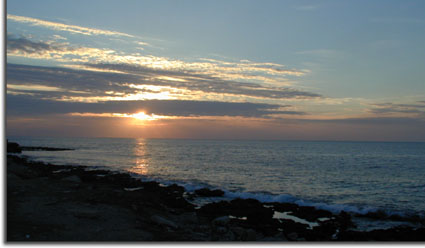 and attitude, then the answer was, “No.” Were people poor? In a
material sense, yes, they were. But they had the basics in food,
shelter and companionship. If you tried to use middle income
America as a measure, the majority of the people came up lacking.
But if you measured against the poverty in Washington, DC, or the
homeless in Seattle, then the Cuban people were far better off.
You may be thinking that we were shown only the best. This is not true.
We had free rein within the country (well, I didn’t get to see the
Soviet submarine pens at Cienfuegos). We could talk to anyone and
go everywhere. I am not a true socialist, nor am I a strict
capitalist. I truth, I tend to fall somewhere in the middle with a
strong leaning toward personal motivation and responsibility. In
my opinion, the Cuban people have been well served. Could they be
better served? Probably. Who couldn’t be in any society, as
there is no perfection. I would return to Cuba. It was quite
an experience.
and attitude, then the answer was, “No.” Were people poor? In a
material sense, yes, they were. But they had the basics in food,
shelter and companionship. If you tried to use middle income
America as a measure, the majority of the people came up lacking.
But if you measured against the poverty in Washington, DC, or the
homeless in Seattle, then the Cuban people were far better off.
You may be thinking that we were shown only the best. This is not true.
We had free rein within the country (well, I didn’t get to see the
Soviet submarine pens at Cienfuegos). We could talk to anyone and
go everywhere. I am not a true socialist, nor am I a strict
capitalist. I truth, I tend to fall somewhere in the middle with a
strong leaning toward personal motivation and responsibility. In
my opinion, the Cuban people have been well served. Could they be
better served? Probably. Who couldn’t be in any society, as
there is no perfection. I would return to Cuba. It was quite
an experience.